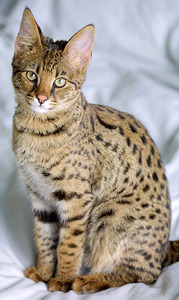|
The Scratching Post
Savannah

The Savannah cat is one of the larger breeds of domesticated cats. This cat has a long neck, long legs and very large ears. The most striking feature is the dark spotting on a lighter coat giving this breed their "wild" appearance. The body of the Savannah is long, with their hind-end being higher than their shoulders. The head is tall and wide and they have a long slender neck. The short tail has black rings, with a solid black tip. The eyes are blue when they are born but turn to shades of green, brown, gold or a blended shade as an adult. Their boomerang-shaped eyes have a slight hooded brow. The eyes also have a "tear-streak" or "cheetah tear" markings which run from the corner of the eyes down the sides of the nose much like the Cheetah.
|
|
Temperament
|
The Savannah cat is friendly, assertive, active and playful. They enjoy playing with children and dogs. Some in this breed are very social with strangers while others may run and hide. Some may even hiss or growl. Early socialization will prevent this kind of behavior. The Savannah has an amazing jumping ability, with some being able to leap about 8 feet from a standing position. This breed is very inquisitive and can be known to get into cupboards as well as open doors. Savannahs love the water and have been known to play in their water bowls until it is empty. The Savannah will chirp and even make a hissing sound similar to a snake.
|
|
Height, Weight
|
Male Weight: 10-25 lbs.; Female Weight: 8-17 lbs.
|
|
Health Problems
|
This breed can have smaller livers relative to their size than other cats. Care must be used when prescribing some medications as they may need a lower dose. They also may not respond well to anesthesia containing Ketamine.
|
|
Living Conditions
|
Savannahs will do fine living indoors, but if you take your cat outdoors, they can be trained to walk on a leash. The ideal home would be with an active family where people were available often for interaction. The Savannah should have a companion cat if left alone for longer than 10-12 hours per day.
|
|
Exercise
|
Though the Savannah enjoys socializing, they are able to entertain themselves by playing with their toys and utilizing a scratching post.
|
|
Life Expectancy
|
About 10-12 years
|
|
Grooming
|
As a short-haired cat, this breed does not require a lot of grooming.
|
|
Origin
|
The first Savannah cat, also named Savannah, was bred by Bengal breeder Judee Frank by crossing a Serval and domestic cat in 1986. Another breeder, Patrick Kelley had been interested in exotic looking domestic cats for many years and purchased one of Savannah?s kittens in 1989. Patrick approached several other breeders in an attempt to develop this breed. In 1996, Patrick, along with Joyce Sroufe wrote the Savannah breed standard and presented it to TICA. The Savannah breed was not recognized by the TICA until 2000. As of 2001, there are approximately 200 registered Savannah cats. The breed is still very rare and quite expensive.
|